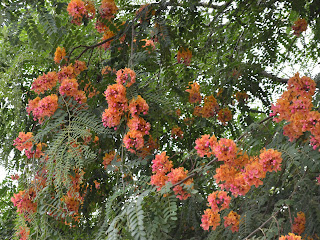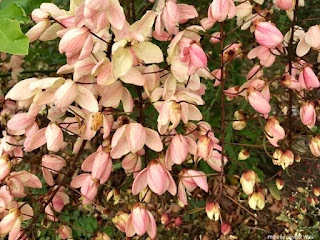In general, most Cassia trees thrive in hot and humid climate and bloom profusely following a prolonged period of dry season. In the tropic, these delightful Cassia trees burst into blooms with spectacular cascades of inflorescences of flowers throughout summer months, which is a sight to behold. On rainy days, the fallen colorful flower petals carpeting the ground underneath the trees looks completely magical. Their blooms are either red, pink, yellow or orange in color. Hybrid offsprings with the blending of traits from these Cassia species produce a wide range of colors that do not normally exist in nature. The blossoms range in hue from deep yellow to white, from pink or red to deep orange, or the combination of these colors (rainbow). Cross pollination between species can occur naturally or it can be facilitated by humans.
 |
| A bright orange Cassia Hybrid in Author's Collection |
Like most species of Cassia, their hybrids are remarkably resilient as they grow in a wide range of soil types. Some of them can reach impressive heights with a rounded or spreading crown. They are drought tolerant, need little amount of care, and produce little or none of seedpods making them ideal for landscape or street applications. Since they are hybrids, their progenies vary widely as they are not true to seed. This article presents a brief information along with a few images of several Cassia hybrid trees from Thailand as well as other parts of the world such as Hawaii, India and Australia. More images and hybrids will be incorporated into this article in the future.
1. Rainbow Shower Cassia
Cassia x nealiae
(Cassia javanica x Cassia fistula)
Rainbow shower tree was first observed in Hawaii as a natural hybrid by forester David Hughes sometime in 1910's. During that period, he also hand-pollinated the flowers of Cassia javanica with pollens from Cassia fistula, then selected and distributed the hybrids to the public and parks. Cassia x nealiae is named after Marie C. Neal, a renowned Hawaiian botanist who authored several books including "In Gardens of Hawaii". Some known hybrids (F1 generation) originally from Hawaii are Wilhelmina Tenney Rainbow, Queen's Hospital White, Lunalilo Yellow and Nii's Gold. While Wilhelmina Tenney is sterile, the other hybrids hardly produce seedpods. Like their parents (C. javanica and C. fistula), young seedpods of these Rainbow Shower hybrids are green in color before turning black with maturity. These hybrids are some of the most popular street and park trees in Hawaii especially in Honolulu. The trees can reach 15 meters or higher in height with canopy width of about 9 meters.
Scientific name: Cassia x nealiae
Common name: Rainbow shower tree, รัตนพฤกษ์ Rattana Preuk (Thailand)
Cross: Cassia javanica x C. fistula (no DNA study to confirm its parentage)
Variety: Wilhelmina Tenney Rainbow, Queen's Hospital White, Lunalilo Yellow and Nii's Gold
Origin: Hawaii
Distribution: Hawaii, Florida, Thailand and many countries in the Tropic.
Note: C. javanica listed as a parent here is likely a species of C. javanica complex before being splitted into several species such as C. javanica, C. agnes, C. renigera, C. nodosa, and etc. DNA study confirmed that C. fistula is one of its parents but C. javanica (formerly C. javanica subsp. javanica syn. C. javanica var. javanica) is not. From the author point of view, C. x nealiae is likely a cross between C. fistula and C. javanica var. indochinensis which has been widely grown in Hawaii at that time.
1.1. Wilhelmina Tenney Rainbow
Cassia x nealiae 'Wilhelmina Tenney'
Wilhelmina Tenney rainbow shower tree has red, pink, yellow, and white blossoms in each cluster. The tree blooms profusely but with no scent. This hybrid was first discovered growing in the grounds of Edward D. Tenney's residence on Makki Heights Drive in Honolulu around 1920. A marcot of the original tree was donated to Foster Botanical Garden in 1940's by Tenney's daughter, Wilhelmina Tenney. In 1965, it was designated as the official tree of Honolulu.
Common name: Rainbow Shower (US), รัตนพฤกษ์ Rattana Preuk (Thailand), คูนสายรุ้ง Koon Sai Roung (named by the author in 1999) (Thailand)
Cross: Cassia javanica (seed parent) and C. fistula (pollen parent)
Origin: Honolulu, Hawaii
Tree type: semi-deciduous
Flowering: April-May and June (Thailand)
Sterility: The tree is sterile.
1.2. Queen's Hospital White
Cassia x nealiae 'Queen's Hospital White'
The Queen's Hospital White was first discovered at Queen's Hospital in Honolulu, Hawaii. It has been introduced into Thailand directly from Hawaii by the author (Kukiat Tanteeratarm) by the year 2000. The Queen's Hospital White is first bloom with light yellow flowers that become a creamy white to almost white with maturity. The tree blooms profusely but with no scent. It produces a few seedpods each year with seeds of irregular shape. However, a few of those seeds are fertile.
Common name: Queen's Hospital White (US), คูนขาวฮาวาย Koon Khao Hawaii (Thailand), เศวตพฤกษ์ (Thailand)
Cross: Cassia javanica and C. fistula
Origin: Hawaii
Tree type: semi-deciduous
Flowering: late March/April-May to early June (Thailand)
Sterility: It yearly produces a few seedpods with some fertile seeds.
Photos by: Kukiat Tanteeratarm
Location: Pathumthani, Thailand
1.3. Lunalilo Yellow
Cassia x nealiae 'Lunalilo Yellow'
Lunalilo Yellow, hence its name, the original growing site of this tree was on Lunalilo street in Honolulu. The tree has buds of yellow orange and newly opened flowers of blight yellow that soften to lighter shade of yellow with age. The flowers are sweetly fragrant.
Note: In general, the flower appearance of Lunalilo Yellow and Cassia fistula (one of its parents) looks somewhat similar. To differentiate them, one has to look into the filament shape of their flower stamens. Three long staminal filaments of Lunalilo Yellow's flowers have a swollen nodule in the middle whereas those of C. fistula have none. Lunalilo Yellow has up to 10 pairs of small size leaflets (about 3 cm wide x 5 cm long) while C. fistula has up to 8 pairs (mostly 5-6) and much larger in size. In addition, Lunalilo Yellow rarely produces seedpods whereas C. fistula annually produces seedpods in abundance.
Common name: Rainbow shower tree, Lunalilo Yellow (US), คูนลูนาลิโล (Thailand)
Cross: Cassia javanica and C. fistula
Origin: Hawaii
Tree type: semi-deciduous
Flowering: April to September (Hawaii)
Sterility: It yearly produces a few seedpods.
Photo (below) credit to Missouri Botanical Garden, St. Louis, Missouri, US
Photo (below) by: Hayataro Sakitsu (Studio Elepaio)
Location: Honolulu, Hawaii, US
 |
| Credit to Studio Elepaio |
Photo (below) by: M. Ritter, J. Reimer, C. Stuber, J. Yost, and W. Mark (Image published in Urban Forest Ecosystems Institute at Poly Cal)
Location: Foster Botanical Garden, Hawaii, US
 |
| Credit to M. Ritter et. al. |
Links to more photos of Lunalilo Yellow from various sources and locations in Hawaii:
1.4. Nii's Gold
Cassia x nealiae 'Nii's Gold'
The Nii's Gold has buds of peachy orange and newly opened flowers of a deep gold fading to rich golden yellow to strong yellow with age. The flowers have delightful subtle perfume. As compared to Lunalilo Yellow, Nii's Gold has flower buds and petals of more intense in color. Nii's Gold was named after Shigeki Nii, founder of the Nii R&S nursery located in Kamilonui Valley, Honolulu. The nursery is now run by the new generation, Richard and Judy Nii. According to Judy Nii (Richard Nii's wife), Nii's Gold is a sport of the Wilhelmina Tenney tree growing in the nursery.
Common name: Rainbow shower tree, Nii's Gold
Cross: Cassia javanica and C. fistula
Origin: Honolulu, Hawaii
Tree type: semi-deciduous
Flowering: April to September (Hawaii)
Sterility: It rarely produces seedpods with a few fertile seeds.
Photos by: Jessica Freund
Location: Miami, Florida, US
2. Ivory White
Cassia x nealiae 'Queen's Hospital White' x C. x nealiae 'Queen's Hospital White'
Ivory White is a sterile hybrid (F2 generation) growing from a seed of Queen's Hospital White (F1 generation) in the early 2000's. It has buds of pale peach and newly opened flowers of ivory to cream fading to almost white with age. The flowers are produced in long pendulous clusters. The tree blooms profusely but with no scent. It can reach 15 meters in height with canopy width of 8-9 meters.
Common name: Ivory White (named by the author) (Thailand)
Cross: A seedling of Cassia x nealiae 'Queen's Hospital White' (likely by self-pollination)
Origin: Author's place in Pathumthani, Thailand
Distribution: None
Tree type: semi-deciduous
Flowering: late March/April to May (Thailand)
Sterility: The tree is sterile.
Photos by: Kukiat Tanteeratarm
Location: Pathumthani, Thailand
3. Pathumthani Gold
Cassia x nealiae 'Queen's Hospital White' x C. x nealiae 'Queen's Hospital White'
Pathumthani Gold is a sterile hybrid (F2 generation) growing from a seed of Queen's Hospital White (F1 generation) in the early 2000's. It has buds of pale peach yellow and newly opened flowers of blight yellow without fading with age. The flowers are produced in long pendulous clusters resembling C. fistula. The tree blooms profusely but with no scent. It is about 15 meters in height with canopy width of 8-9 meters.
Common name: Pathumthani Gold (named by the author)
Cross: A seedling of Cassia x nealiae 'Queen's Hospital White' (likely by self-pollination)
Origin: Author's place in Pathumthani, Thailand
Distribution: None
Tree type: semi-deciduous
Flowering: late March/April to May (Thailand)
Sterility: The tree is sterile.
Photos by: Kukiat Tanteeratarm
Location: Pathumthani, Thailand
4. Siam White
Cassia x siamensis
(Cassia fistula x Cassia bakeriana)
The original tree was first discovered on a roadside in a rural area in Saraburi province, Thailand by locals in 1990's. The author visited this tree in 2002 and later took samples for DNA analysis. It was found to be a cross between Cassia fistula and Cassia bakeriana before being named "Siam White" by the author. In 2024, the original tree is over 15 meters in height and 8-9 meters in canopy width.
Siam White has buds of strong yellow and opened flowers of yellow fading to white with age. The flowers are produced in long pendulous racemes resembling those of C. fistula but both flowers and racemes are significantly larger in size. Its floral scent is noticeable upon approaching the tree in full bloom. This hybrid yearly produces a lot of extra long seedpods (can be 1 meter or more in length) filled with mostly fertile seeds. Young seedpods of Siam White are uniquely bicolors in appearance which is the characteristic found in those of C. bakeriana (one of Siam White's parents). Its colors are initially burgundy with lime green stripes along the seedpod length before turning black with maturity.
 |
| Young seedpods of Siam White |
Note: Unlike young seedpods of Siam White from Thailand, those of Queen's Hospital White from Hawaii are totally green in color. The bicolor characteristic on young seedpods can be used as a key criteria to distinguish Siam White from Queen's Hospital White as well as other Cassias i.e. C. fistula, C. javanica and many other Cassia species/hybrids. More detail information related to Siam White is in this link: Siam White
Scientific name: Cassia x siamensis - a proposed name by the author to honor the country of origin
Common name: Siam White (named by the author), คูนขาวไทย Koon Khao Thai (Thailand), วัชรพฤกษ์ Vajrapruk (named by Surawit Wannakrairoj) (Thailand)
Cross: natural cross between Cassia fistula and Cassia bakeriana (confirmed by DNA analysis and morphological study)
Origin: Saraburi, Thailand
Distribution: Thailand, and recently being introduced into countries in S.E. Asia and S. Asia
Tree type: semi-deciduous
Flowering: late March/April to May (Thailand)
Sterility: It produces abundance of seedpods with mostly fertile seeds.
Photos by: Kukiat Tanteeratarm
Location: Pathumthani, Thailand
5. Lancaster Cassia
Cassia x lancasterii
(Cassia roxburghii x Cassia javanica)
According to Michael D. Ferrero (an Australian horticulturist), Cassia x lancasterii is a cross between Cassia roxburghii (syn. C. marginata) and Cassia javanica. The cross was made in 1950's in Calcutta, India by Percy Lancaster. Lancaster was a wel-known horticulturist/plant hybridizer who has dedicated his life to serving the Agri. Horticultural society of India in Calcutta and the National Botanic Garden of India. Later, the cross has also been repeated by local Bangalorean gardeners as well as by natural cross. There are several distinct cultivars from this cross which are sterile to partially sterile. Their flowers are various in sizes, forms and colors ranging from reddish pink to pink or to orange and yellow. Note that three long staminal filaments of these hybrids have a small swollen nodule in the middle whereas those of C. roxburghii (one of their parents) have none. The average height of these trees is about 10-12 meters with canopy width of 8 meters.
Scientific name: Cassia x lancasterii - According to Micheal D. Ferrero, this hybrid was named after Percy Lancaster.
Common name: Lancaster Cassia
Cross: Cassia roxburghii x C. javanica (no DNA confirmation on the pollen parent)
Origin: Bangalore, India
Dstribution: Southern India and Thailand
Tree type: semi-deciduous
Flowering: May to July (India)
Sterility: They are sterile to partially sterile with a few fertile seeds.
Photos (below) by: Micheal D. Ferrero
Location: Bangalore, India
Photos (below) by: Sahastra Rashmi (An intimate encounter with the lovely red cassia published in The Green Ogre)
Location: Pondicherry, India
6. Kukiat's Cassia roxburghii hybrid (Summer Shower Cassia)
Cassia roxburghii x Cassia sp.
Summer Shower tree was grown from Cassia roxburghii 's seed in author's garden in the early 2010s. This is a large semi-evergreen tree that can be over 15-18 meters in height with spreading and drooping branches of 10-12 meters in width. Summer Shower has rich pink, rosy orange and peach/apricot to deep yellow blossoms in each cluster with light sweet floral scent.
Note: Based on a recent DNA study, Summer Shower is not Cassia roxburghii but very closely related to it. As compared to C. roxburghii (its seed parent), Summer Shower is a much larger tree. Three long staminal filaments of Summer Shower have a swollen nodule in the middle whereas those of C. roxburghii have none. Both DNA and morphological studies suggest that Summer Shower is a hybrid. In addition, DNA study also revealed that C. javanica (C. javanica subsp. javanica) is not the pollen parent. Interestingly, Summer Shower from Thailand is quite similar to a few of the C. roxburghii hybrids from India. In this particular case, the similarity might be because of coincidentally having the same parentage.
Scientific name: -
Common name: Summer Shower (named by the author)
Cross: a natural cross between Cassia roxburghii (seed parent) and an unknown Cassia other than Cassia javanica subsp. javanica (based on DNA study)
Origin: Author' place in Pathumthani, Thailand
Distribution: None
Tree type: semi-evergreen
Flowering: April-June (Thailand)
Sterility: It has set only a seedpod with sterile seeds.
Photos by: Kukiat Tanteeratarm
Location: Pathumthani, Thailand
7. Jennifer Willis' Cassia javanica hybrid
Cassia javanica x Cassia sp.
According to Jennifer Willis (an Australian plant enthusiast), it is her own seedling that she germinated from Cassia javanica. The flowers of this hybrid are produced in long pendulous clusters resembling those of C. fistula but with lovely yellow and rosy pink in color. This suggests that the flower of C. javanica was most likely pollinated naturally with pollens from C. fistula. It is worth closely monitoring this hybrid especially when it grows into a full size tree.
Scientific name: -
Common name: -
Cross: natural cross between Cassia javanica (seed parent) and an unknown Cassia species (likely C. fistula)
Origin: Queensland, Australia
Distribution: None
Tree type: semi-deciduous
Flowering: no record
Sterility: no record
Photos by: Jennifer Willis
Location: Queensland, Australia
8. Adam Pollak's Cassia bakeriana hybrid?
Cassia bakeriana x Cassia sp.?
According to Adam Pollak, a number of small seedlings of Cassia bakeriana were acquired from local nurseries in Miami area, Florida. All seedlings look like regular C. bakeriana but one of them shows bloom characteristics different from the others. The flowers start with pink before fading with age to yellow instead of white (which is normally seen in C. bakeriana). As the regular C. bakeriana trees in south Florida start to bloom in March, this Cassia blooms in May every year. This is a possible hybrid and deserves more investigation.
Scientific name: -
Common name: -
Cross: Cassia bakeriana (seed parent) x an unknown Cassia species?
Origin: Loxahatchee, Florida
Distribution: None
Tree type: semi-deciduous
Flowering: May-June (Florida, US)
Sterility: no record (needs further investigation)
Photos by Adam Pollak
Location: White Fence Arboretum, Loxahatchee, FL, US
9. Lailson Oliveira Gouveia Cassia
Cassia ferruginea x Cassia grandis?
The cassia tree with long graceful pendent inflorescences composed of flowers with colors other than yellow is something that most cassia hybridizers and growers have long dreamed about. Lailson Oliveira Gouveia, a Brazilian nursery man from Rio Verde in Brazil, discovered such cassia tree in the state of Goiás and revealed his finding to the public in 1917. It is a truly magnificent cassia and undoubtedly looks great in any gardens. This Cassia is named (by author) to honor Lailson Oliveira Gouveia, an agriculturalist who introduced this wonderful tree to the world.
Cassia ferruginea x Cassia grandis?
The cassia tree with long graceful pendent inflorescences composed of flowers with colors other than yellow is something that most cassia hybridizers and growers have long dreamed about. Lailson Oliveira Gouveia, a Brazilian nursery man from Rio Verde in Brazil, discovered such cassia tree in the state of Goiás and revealed his finding to the public in 1917. It is a truly magnificent cassia and undoubtedly looks great in any gardens. This Cassia is named (by author) to honor Lailson Oliveira Gouveia, an agriculturalist who introduced this wonderful tree to the world.
The blossom with mixed shades of colors on Gouveia Cassia tree is a real show-stopper. Its flowers are produced in a long and pendulous raceme which is an unique characteristic found only in some species of Cassia such as C. ferruginea (native to Brazil), C. fistula (native to S. Asia and S.E. Asia), C. x siamensis (a hybrid from Thailand), and C. burtii (native to Tanzania and Mozambique). Note that most species of Cassia native to Australia also have pendulous raceme but with a much smaller in size and length. The flowers of Gouveia Cassia start with yellow in color then turn peach and coral red with maturity. It was reported to have a nice and very fragrance as well. Its leaves are narrowly oblong which is the leaf shape found in most cultivated Brazilian native cassias including C. ferruginea, C. grandis, C. moschata and C. fastuosa.
From author's opinion, Gouveia Cassia hybrid is likely a natural cross between two Brazilian native cassias, C. ferruginea and C. grandis. Of all Cassias native to Brazil, only the flowers of C. ferruginea are produced in a long and pendulous raceme. Both C. ferruginea and C. grandis also share the characteristic of narrowly oblong leaf shape. In addition, peach to coral red shades of flowers in Gouveia Cassia hybrid are also the coloration found in C. grandis.
Scientific name: -
Common name: Lailson Oliveira Gouveia Cassia (named by the author)
Cross: likely a cross between Cassia ferruginea and Cassia grandis (no DNA confirmation)
Origin: The state of Goiás, Brazil
Distribution: n/a
Tree type: semi-deciduous to evergreen
Flowering: n/a
Sterility: The tree produces cylindrical seedpods with fertile seeds.
Photos credit to Lailson Oliveira Gouveia and Laine Gouveia
Location: The state of Goiás, Brazil


















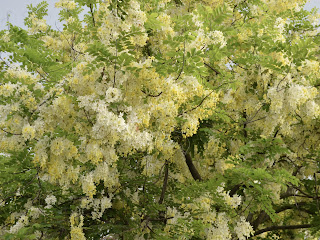









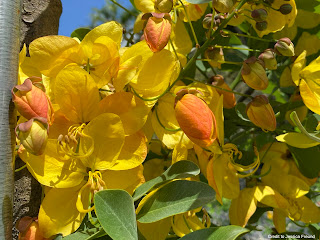



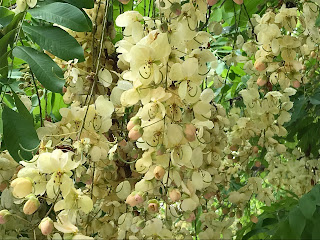
























%20young%20seedpod%20with%20candy%20cane%20striped%20appearance%20(note%20QHW%20has%20green%20calyx%20and%20green%20young%20seedpod)a..jpeg)












